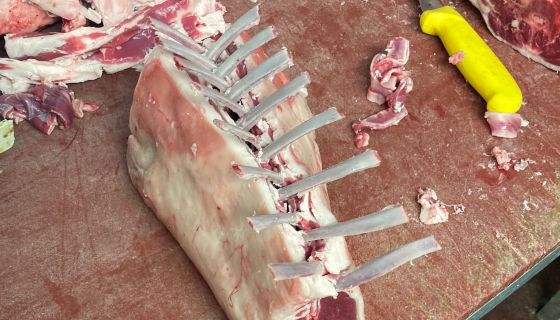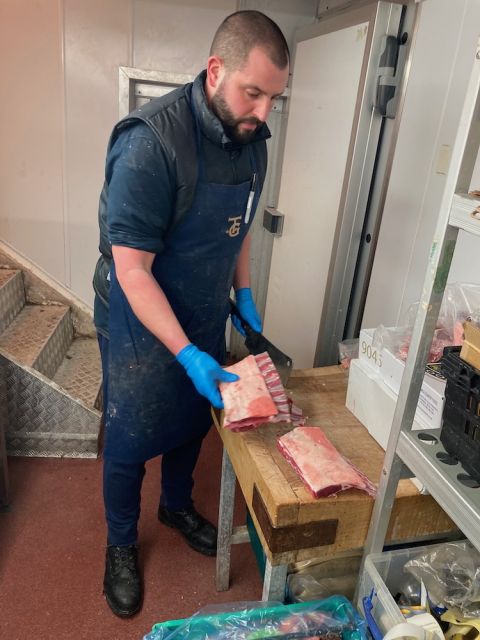I followed Tom Richardson-Hill down the stairs of the butcher’s Turner & George in Islington with some hesitancy. The steps were steep, slightly slippery and the basement smelt, not surprisingly, of raw meat. ‘This has been a butcher’s shop since the 18th century’, he promptly informed me. Its wholesale arm supplies the meaty restaurant group Hawksmoor.
This was to be the end of the trail, the place where I’d find an answer to a question that has been bothering me for the best part of 15 years. Why, I have wanted to know, have the vast majority of chefs apparently turned their backs on a rack of lamb as a main course?
Until 20 years ago, a rack of lamb was a staple on restaurant menus across Europe as well as the go-to dish for any amateur cook giving a dinner party. It could be spiced up or served quite plain. It could be accompanied by virtually anything. It involved enough red meat to satisfy any carnivore (there were many more of us in those days). And a rack of lamb looked good, either standing upright, if it was served whole, or cut up into cutlets and laid out on a platter.
During my time as a restaurateur the menu would change every six weeks but the rack of lamb was constant, even if its accompaniments would vary: a tian of aubergines; a mustardy gravy; a garlic puree. It was also the main course that took the longest to cook, about 25 minutes with the necessary resting time out of the oven.
It was immensely popular and, even 35 years ago, one of the most expensive dishes on the menu. This is not unconnected to its disappearance.
Unlike cattle, lambs are farmed wild and need shepherding, often on smaller, family farms rather than on bigger ones with their economies of scale. They are smaller than cattle and produce less meat when butchered. All lambs have a pretty low yield and young lambs, those available at Easter for example, produce all too little edible meat. Anyone who has read James Rebanks’ emotive tale of his life as a Lakeland sheep farmer, The Shepherd’s Life, will appreciate these unavoidable facts.
In very urban Islington, Richardson-Hill hauled a lamb carcass out of the cold store and on to his butcher’s block. ‘This one weighs 21 kg. They are all around 20–25 kg at this time of the year, and they cost us £6.50 to £7 a kilo. It will yield two of everything: two legs; two shoulders from the front of the lamb, which is where the lamb shanks come from; two breasts; two racks of lamb from what is referred to as the best end; two kidneys; oh, and one saddle.’
He began cutting it up and within 15 minutes he had finished. The shoulders came away easily. The saddle next, followed by the ‘best end’. Richardson-Hill expertly French-trimmed the two racks of lamb, each comprising eight bones, a total of 16 lamb chops that would constitute no more than five servings. He put these on the scales and they weighed 1.415 kg. ‘Selling this to a chef at £40 per kilo, the same price as dry-aged beef, that will generate about £60 in total or about half the total cost of the lamb to us. A rack of lamb today costs any restaurant chef about £9 a portion and so will have to go on any menu for as much as £35 or £40’, he explained.
We then examined what was left. The two legs, each 2.6 kg, would generate £50 each; the two lamb shoulders a further £40 each; there was the saddle and there was a considerable amount of breast. ‘The breasts of lamb have never been very popular other than to numerous Turkish restaurants where the chefs cut them up, marinate them, roast them and serve them as a first course. They are tasty and, like every butcher in the country, I hope that the same thing happens with these as happened to bone marrow when St John restaurant started serving them roasted as a first course topped with a parsley salad. Suddenly everyone wanted bone marrow. If that were to happen, we would have a national shortage of breast of lamb’, he laughed.
A rack of lamb has invariably been a prime cut and has therefore always been expensive. The wholesale arm of Turner & George continues to supply several leading restaurants with them, including more than a ton a week to Dishoom, the group of Indian restaurants, which serves them as marinated lamb chops, and it is on the menu at Rules and Wiltons. But its escalating price and its rather conservative appeal have, I believe, led today’s chefs to pass it by.
Michel Roux Jr, chef-patron of London’s Le Gavroche, added two additional reasons for the disappeared rack of lamb. ‘As sous-vide preparation becomes increasingly common, the rack, with its numerous bones, has lost its appeal to many chefs. And with the limited availability of talented front-of-house staff to carve and present this dish in front of the customers, a rack of lamb may have already become an item of menus past.’
James George of Turner & George added Brexit and COVID-19 as two further reasons for the 50% increase in his wholesale price of a rack of lamb, as well as the rise in the cost of speciality butchering.
I intend to treat myself to at least one rack of spring lamb in the near future. But I will now regard it as a luxury.















